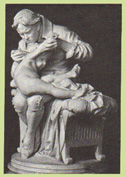
Statue of Edward Jenner (1749-1823) Mansell Collection
|
|
|
|
|
|
|
|
|
|
|
|
|
|
|
|
|
|
 |
Statue of Edward Jenner (1749-1823) Mansell Collection |
| Showing Jenner transferring pus from the hands of someone infected with cowpox into scratches in the skin of a young boy. |
SO, WHO WAS EDWARD JENNER?
Edward Jenner was an English country doctor who pioneered vaccination. Jenner's discovery in 1796 that inoculation with cowpox gave immunity to smallpox, was an immense medical breakthrough and has saved countless lives.
Edward Jenner was born on May 17 1749 in the small village of Berkeley in Gloucestershire. From an early age Jenner was a keen observer of nature and after nine years as a surgeon's apprentice he went to St George's Hospital, London to study anatomy and surgery under the prominent surgeon John Hunter. After completing his studies, he returned to Berkeley to set up a medical practice where he stayed until his death in 1823.
HOW DID EDWARD JENNER DISCOVER VACCINATION?
Jenner worked in a rural community and most of his patients were farmers or worked on farms with cattle. In the 18th century smallpox was a very common disease and was a major cause of death. The main treatment was by a method which had brought success to a Dutch physiologist Jan Ingenhaus and was brought to England in 1721 from Turkey by Lady Mary Wortly Montague. This method involved inoculating healthy people with substances from the pustules of those who had a mild case of the disease, but this often had fatal results.
In 1788 an epidemic of smallpox hit Gloucestershire and during this outbreak Jenner observed that those of his patients who worked with cattle and had come in contact with the much milder disease called cowpox never came down with smallpox. Jenner needed a way of showing that his theory actually worked.
Jenner was given the opportunity on the 14 May 1796, when a young milkmaid called Sarah Nelmes came to see him with sores on her hands like blisters. Jenner identified that she had caught cowpox from the cows she handled each day.
 |
|
| The hand of a person infected with cowpox |
Jenner now had the opportunity to obtain the material try out his theories. He carefully extracted some liquid from her sores and then took some liquid from the sores of a patient with mild smallpox.
Jenner believed that if he could inject someone with cowpox, the germs from the cowpox would make the body able to defend itself against the dangerous smallpox germs which he would inject later.
Jenner approached a local farmer called Phipps and asked him if he could inoculate his son James against smallpox. He explained to the farmer that if his theory was correct, James would never contract smallpox. Surprisingly, the farmer agreed.
Jenner made two small cuts on James's left arm. He then poured the liquid from Sarah's cowpox sores into the open wounds which he bandaged.
James went down with cowpox but was not very ill. Six weeks later when James had recovered, Jenner vaccinated him again, this time with the smallpox virus.
This was an extremely dangerous experiment. If James lived Jenner would have found a way of preventing smallpox. If James developed smallpox and died he would be a murderer.
To Jenner's relief James did not catch smallpox. His experiment had worked.
In 1798 after carrying out further successful tests, he published his findings: An Inquiry into the Causes and Effects of the Variolae Vaccinae, a Disease Known by the Name of Cow Pox. Jenner called his idea " vaccination" from the word vaccinia which is latin for cowpox. Jenner also introduced the term virus.
Jenner found a great deal of scepticism to his ideas and was subject to much ridicule. A cartoon was drawn, showing cows coming out of various parts of people's bodies after they had been vaccinated with cowpox.
| |
' The Cow Pock or the wonderful effect of the new inoculation '. From an etching by James Gillray (1757-1815), illustrating some of the ridiculous ideas being circulated by opponents of Jenner's work. |
| Photo, Wellcome Historical Museum. |
However, Jenner persevered and eventually, doctors found that vaccination did work and by 1800 most were using it. Jenner was awarded £30 000 by Parliament to enable him to continue carrying out his tests. Deaths from smallpox plummeted and vaccination spread through Europe and North America.
Jenner died in Berkeley on January 26, 1823 aged 74.